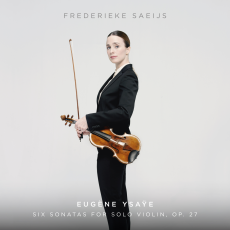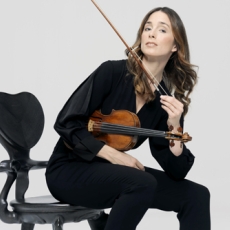Frederieke Saeijs - Ysaye: Six Sonatas - De Volkskrant
Frederieke Saeijs' performance belongs at the forefront
Former ‘violin girl' Frederieke Saeijs has become a musician with a clear personality, as evidenced by her second CD, which she has devoted entirely to the six sonatas for solo violin that the Belgian violinist and composer Eugène Ysaÿe wrote in 1923. While the work is not very well known, it is no longer an insider secret and there are different recordings available. There's no doubt Saeijs' version belongs at the absolute forefront.
The six sonatas are very different in character and length. A common feature is that, while the violin and the technique play a leading role, they are never more important than what the composer has to say. And that is quite a lot. The music teems with references to diverse styles and pasts, but also contains all manner of special effects, including quarter-tones.
From the very first bars, Saeijs' performance stands out because of its great clarity, but it becomes ever more fascinating to hear what a fantastic musical storyteller she is. In this, she goes all out, but doesn't fight shy of the lower part of the spectrum and in her dialogue with Ysaÿe's notes avoids everything that appears to be overwhelming. The recording strengthens this even more with an excellent balance between openness and directness.
Original (Dutch) text:
Frederieke Saeijs' uitvoering hoort in de voorste voorhoede
Voormalig vioolmeisje Frederieke Saeijs is een musicienne met een uitgesproken persoonlijkheid geworden, zo blijkt op haar tweede cd, die ze geheel gewijd heeft aan de zes sonaten voor viool solo die de Belgische violist en componist Eugène Ysaÿe in 1923 componeerde. Hoewel het werk niet zo heel bekend is, is het intussen geen geheimtip meer en zijn er verschillende opnamen voorhanden. Saeijs' versie hoort absoluut in de voorste voorhoede.
De zes sonaten zijn heel verschillend van sfeer en lengte. Gemeenschappelijk kenmerk is dat de viool en haar techniek dragende factor zijn, maar nooit belangrijker dan wat de componist te zeggen heeft. Dat is niet gering. De muziek wemelt van allusies aan diverse genres en verledens, maar bevat ook allerlei special effects, waaronder zelfs kwarttonen.
Saeijs' uitvoering valt vanaf de eerste maten op door haar grote helderheid, maar gaandeweg is het nog boeiender te horen wat een fantastisch vertelster-in-muziek hier aan het woord is. Ze zet daarbij alles op alles, maar schuwt de onderkant van het spectrum niet en gaat in haar dialoog met Ysaÿes noten alles wat op epateren lijkt uit de weg. De opname versterkt dat nog met een prima balans tussen ruimtelijkheid en directheid.

